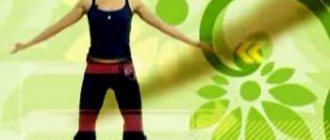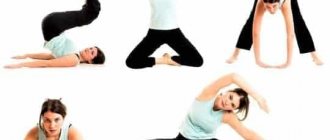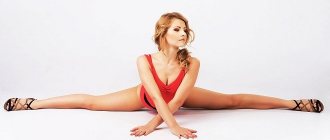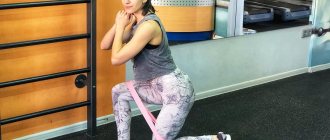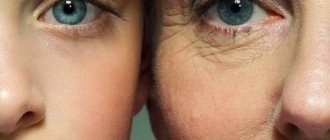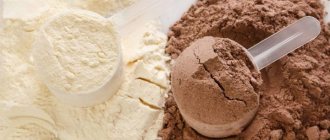Callanetics is one of the “female” areas of fitness, related to yoga, but having a number of distinctive features. This is not the easiest training option, but it has become widespread due to its effectiveness. On the Internet you can find a large number of videos on callanetics for beginners, including those with the participation of the direct creator of this technique.
Who invented callanetics
The callanetics method was developed by US-born Callan Pinckney. Callan was born with a spinal deformity, causing one leg to be slightly shorter than the other. Due to joint pathology, the girl was forced to walk in special braces. Despite this, she studied ballet for several years and led an active lifestyle.
Callan traveled halfway around the world, but travel had a negative impact on her health. After returning home, she was tormented by pain in her back and joints, and doctors suggested surgical treatment. However, Callan decided not to rush into the operation, but turned to her childhood hobby - ballet. Based on ballet steps, she developed the first exercises of callanetics - a direction to which she gave her name.
Thanks to Pinkney's classes, the symptoms of the disease were significantly reduced. Then she began teaching everyone, and in the 1980s the direction became very popular. Callan Pinkney has published several books and collections of training videos for beginners and more experienced athletes. She claimed that by doing callanetics, you can gain back 10 years of life. At the same time, she herself was an illustration of these words, since she looked younger than her age and could boast of a chiseled figure.
Is callanetics suitable for pregnant and lactating women?
If you regularly practiced callanetics before pregnancy, then you do not need to cancel your training, you just need to adjust it. Callan Pinkney has compiled a special training for expectant mothers - the exercises are smooth, gentle and will not harm the baby in any way. And some of them will only prepare the birth system for a more comfortable birth.
The classes are mainly focused on stretching, and from the second trimester special gymnastics are introduced for the back and pelvic muscles, which allow you to maintain correct posture. But exercises for the abdomen, as well as upward stretching movements, are strictly contraindicated for pregnant women.
Breastfeeding mothers can begin regular exercise when their doctor allows them to increase physical activity after childbirth. This usually happens after a month or two, but for those who have undergone a cesarean section, such training will be contraindicated for a long time.
Why callanetics is better than other types of gymnastics
During callanetics classes:
- All muscle groups work;
- Posture is straightened;
- Excess weight is lost;
- Blood flow and oxygen distribution throughout the body improves;
- Pathologically increased muscle tone decreases;
- Increases mobility and plasticity of the musculoskeletal system;
- A muscle corset appears;
- Pain syndrome decreases;
- Coordination of movements improves.
Many people believe that this type of gymnastics called callanetics is much more effective than other fitness options.
Callanetics and yoga
Callanetics is similar to yoga in form, but not in essence. Yoga is primarily a spiritual practice that helps a person find harmony with himself and nature. The gymnastic component in this case is secondary, less attention is paid to it. It should be borne in mind that this approach often repels people who seek physical benefits from yoga.
Callanetics is not a direction of spiritual development. It is aimed at helping the body - strengthening it, healing it, getting rid of excess fatty tissue. That is why she is so attractive to the fairer sex.
Peculiarities!
Callanetics is considered specifically “female” gymnastics because of the smoothness and measuredness of the training - men prefer more dynamic or strength sports. Nevertheless, callanetics helps to gain muscle mass without “pumping” the muscles. The body becomes more prominent and slender.
Callanetics and Pilates
Pilates is based on dynamic strength training at a slow pace. Callanetics is not considered strength training, but it helps fight excess weight or stay fit during pregnancy better than Pilates. The latter is contraindicated for women at any stage of pregnancy, as well as for people with a high degree of obesity.
Another advantage of callanetics over Pilates is its focus on working all muscle groups, even “hidden” ones, which practically do not function in our everyday life. They begin to tense up, due to this additional energy is burned and the body shape improves.
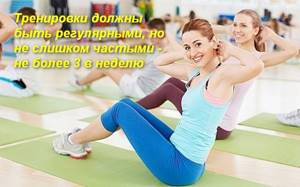
Callanetics and shaping
Shaping includes elements of dynamic cardio training; it significantly increases heart rate and blood pressure. Therefore, shaping can be harmful for people with severe diseases of the cardiovascular system. Callanetics is better for them because it requires a calm pace and has a relaxing effect.
Note!
All the pros and cons of different gymnastics areas are relative; each person independently chooses the direction of training depending on the final goal and physiological characteristics.
Advantages of the complex
Callanetics is not just a set of exercises, but a methodological technique. You should spend 90-120 seconds contracting or stretching a specific muscle group.
The main advantage is the ability to turn any exercise into callanetics: from wall squats to deadlifts with half the working weight. Everyone chooses for themselves what is closer to them.
The original complex is good because:
- No need to buy rugs, leggings, elastic bands, sports bras or sneakers. Any old pants, a comfortable bra, and a T-shirt will do. With the money you save you can buy yourself some greens and chicken breasts.
- You can create a set of your favorite exercises yourself, turning them into static ones. Or you can go to YouTube and find a lot of videos for classes.
- The training can be carried out in any conditions. Is the baby sleeping? No problem, no jumping, shortness of breath and music. Early in the morning and late in the evening, on a trip and at home - this is a universal workout, if you don’t look for excuses.
- The likelihood of injury is minimal. Even if the client has poor coordination, he can sit in a chair, bend over to pick up a fallen object, and raise his arm. Great physical qualities are not required for callanetics.

© zinkevych — stock.adobe.com
Contraindications
Callanetics is not recommended for people:
- With severe heart failure;
- With bronchial asthma;
- With severe visual impairment;
- Suffering from acute infectious diseases;
- Those who underwent abdominal surgery less than 1-1.5 years ago;
- Suffering from hemorrhoids;
- Those with unstable intervertebral hernias.
Important!
Patients with varicose veins of the lower extremities should exercise with caution. Exercises that put stress on the leg muscles are contraindicated for them, as this can provoke thromboembolism.
Callanetics exercises: recommendations
The rules for practicing callanetics differ from those for other types of gymnastics:
- It is better to refuse musical accompaniment, it only disrupts the uniform rhythm of breathing;
- Training should be regular, but not too frequent - no more than 3 per week;
- The optimal duration of holding one pose is 60-100 seconds. But it needs to be built up gradually;
- It is important not only the duration of holding each pose, but also the correctness of the tasks;
- Therefore, for beginners, it is recommended to do the first exercises under the supervision of a fitness trainer;
- All elements are performed against the background of measured breathing, without pauses or deep breaths;
- All movements are smooth and leisurely;
- For one lesson, 15-17 exercises are enough, 5-10 approaches for each.
Operating principle
Callanetics is a set of exercises performed in a static-dynamic version. Namely, a small group of muscles is included in the work (the lower the level of training, the fewer muscles should be included), which is constantly under tension (static), but at the same time performs movements (dynamic). For example, if you do a squat and hold at the bottom point, after 20-40 seconds your muscles will begin to burn strongly, to allow the muscles to remain tense longer to achieve the effect, you need to perform a slight “relaxation”, i.e. stand up a little and sit down again. This way you move up and down without relaxing your legs. It is worth immediately noting that these movements are barely noticeable, i.e. amplitude is minimal.
Callanetics exercises are performed until “failure”, when you literally can no longer keep your muscles tense. For an advanced level, the exercise is performed for 90-100 seconds; for beginners, 40 seconds will be enough; as you adapt, the time increases.
Exercises are performed without pauses, i.e. did one thing, held it for 100 seconds, moved on to another. No breaks between sets.
Be sure to control your breathing - under no circumstances should you hold or talk while performing the callanetics exercise - slow, calm breathing through your nose.
Workout for Beginners
If you are learning callanetics yourself, at home, then for beginners it will be useful to practice in front of a mirror. This way you can independently monitor the correctness of tasks.
- Stand up straight, place your palms on your waist, pull in your stomach and buttocks. Raising your chin slightly, smoothly turn your head to the right and then to the left.
- Spread your legs wider, extend your arms straight towards the ceiling. Stretch up for a few seconds, then bend your legs slightly, stretch your arms and body forward. Then, without changing position, move your arms back and tilt your head back slightly.
- Extend your right arm toward the ceiling, and your left arm along your body. Pull upward with your right hand and slowly tilt your body to the left. Make sure your pelvis remains level and your hips do not shift. Duplicate the bends in the opposite direction.
- Sit in a chair with armrests, rest your hands on them. Keep your back straight, chin slightly raised. Holding the armrests with your hands, slowly straighten them, rising above the chair.
- Sit on the floor and bring your legs straight together. Reach your feet with your fingers, keeping your spine straight, trying to rest your forehead on your knees.
- Lie on your back, bend your knees. Grab your inner thighs with your palms and lift your head and shoulder girdle above the floor. Then, without your shoulder blades touching the horizontal surface, throw your head back parallel to the floor and hold it suspended.
What else can you do while doing callanetics?
This is useful advice for those who have been interested in fitness for several months and know every word of the instructor by heart. You can fight the lack of time for a full workout.
Again, from my experience. I manage to combine several exercises from the warm-up and the main part, which are done standing, with cooking at the stove (there are always 3 minutes while something is steamed or fried), with checking my eleven-year-old daughter’s homework, and playing with cars with my one-and-a-half-year-old son ( my legs act as arches), with a conversation on headphones with my friends (they tell their news to the measured panting).
I combine static exercises, which require sitting and lying down, with watching TV news, favorite programs and films. You can also listen to recordings of trainings on personal growth, “The Forsyte Saga,” figuratively speaking, and learn English. Naturally, I insert the callanetics disc into a portable DVD player and turn off the sound. Now it’s enough for me to see out of the corner of my eye when to start and finish an exercise, when to rest and restore my breathing.
Benefits for pregnant women
In the normal course of pregnancy, elements of callanetics are not contraindicated even in the third trimester. Training will help:
- Don't gain too many pounds;
- Get rid of back pain, which bothers 50% of pregnant women;
- Prevent the formation of edema;
- Tune in to positive emotions;
- Strengthen the pelvic floor muscles, which will facilitate the birth process;
- Keep in shape after childbirth.
However, callanetics is not used for weight loss after childbirth if a caesarean section was performed.
Note!
Callanetics and other types of fitness cannot be practiced in case of threatened miscarriage, abruption or placenta previa, preeclampsia, or increased uterine tone.
Video lessons for those who want to lose weight
On the Internet, anyone who wants to lose weight can watch video lessons, including in Russian, in which qualified trainers teach for free the principles of correct implementation of callanetics according to all the rules of this method. At the same time, trainers teach subtleties, give advice, teach how to enhance results and warn about typical mistakes of beginners. Here are the most popular video courses of specialists:
- Callanetics with Callan Pinckney is the most common video course, since Pinckney is the direct author and creator of the technique. Photos of her followers before and after a month of training are striking in the difference in the condition of the muscles and the figure as a whole.
- Callanetics with Ekaterina Rykova has become the domestic technique that has found a lot of fans due to the accessibility of the trainer’s explanations and the accuracy of the basic rules of the technique.
- Callanetics with Inga Dubodelova requires only desire, free time and a gymnastics mat. Her exercises are an effective way to lose weight. Downloading such a tutorial is a matter of a couple of mouse clicks.
- Callanetics with Tatyana Rogatina has an interesting approach. The coach is a graduate of the School of Olympic Coaches in Moscow. For all techniques, Tatyana chose only the most effective characteristics, which she shares free of charge in her videos.
Important! The listed videos are accompanied by detailed explanations of each exercise, presented from different angles.
For those who are just starting to master the interesting technique of callanetics, videos are a great help, because they allow you to control the duration of the execution and hone the technique to automaticity.
Back workout
- Stand up straight. Stretch your straightened arms to the sides, then forcefully turn them with your palms up. Slowly move your arms straight back, trying to connect your shoulder blades and thumbs.
- Get on all fours, then gradually straighten your legs, resting only the toes of your feet on the floor. The arms and body form a straight line. The vertex of the resulting angle becomes the pelvis.
- Lie on your stomach with your left arm bent under your head and your right arm extended forward. At the same time, lift and hold your head, right arm, and left leg. Then switch limbs.
- Roll over onto your back, clasp your hands together and place them behind your head so that your elbows point to the sides. Bend your knees, raise your shins parallel to the floor. Raise your head and shoulder blades. Twisting your body, alternately reach your right elbow to your left knee and vice versa.
Number of workouts
Callan Pinkney herself recommended initially training three times a week for 60 minutes. They train in this mode for about 2 weeks. After a clear effect appears (reduction of pain, weight loss), you can exercise twice a week. And after achieving the desired result, 60 minutes of exercise over 7 days is enough to maintain physical fitness. These minutes can be distributed evenly throughout the week. For example, exercise every other day for 20 minutes as a morning exercise routine.
Diet when practicing callanetics
A set of callanetics exercises is not the only thing that is necessary to lose weight and maintain a healthy body. The role of nutrition in this process is also significant. First of all, the diet is important. Meals should be relatively evenly distributed throughout the day. The highest energy value comes from breakfast, lunch and dinner. Between them you should take small snacks: it is better to eat more often, but in small quantities. Nutritionists advise eating at one time the amount of food that will fit in your palms. It is advisable to train at least 1.5 hours after eating, otherwise you may experience discomfort in the stomach.
Nutrition must be balanced in fats, carbohydrates and proteins, and contain sufficient amounts of vitamins and minerals. Preference is given to foods with a low glycemic index: legumes, mushrooms, spinach, zucchini, avocados, apples, citrus fruits, nuts, and dairy products. All these dishes provide a feeling of fullness for a longer period and do not increase blood sugar. You need to give up fatty meats and fish, pastries, and sweets. They are allowed to be eaten only occasionally, as an exception.
It must be remembered that in addition to normalizing weight, callanetics helps to tidy up the joints, spine and muscles. It was developed specifically as a therapeutic technique, and its effectiveness has been confirmed by many patients suffering from osteochondrosis, arthritis, and osteoarthritis. Callanetics can be combined with other physical training.
What is callanetics in fitness?
Callanetics is a new direction in fitness, developed by American trainer Callan Pinckney .
The exercises are reminiscent of yoga, but have their own characteristics. The author of this set of exercises set a goal to get rid of pain in the joints and back, so this technique will help patients with osteochondrosis.
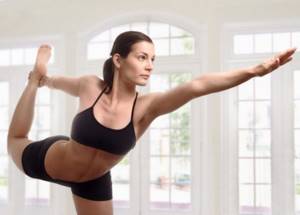
Callanetics will help get rid of back pain
